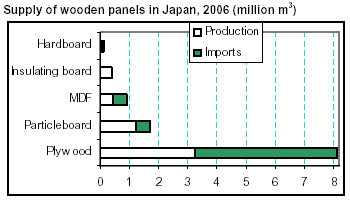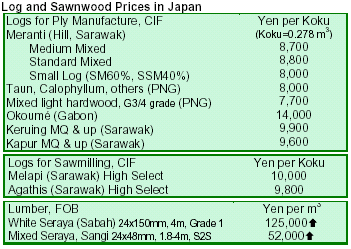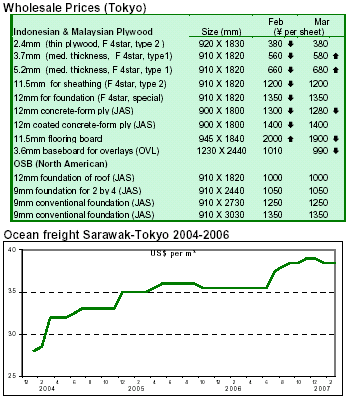|
Japan
Wood Products Prices
Dollar
Exchange Rates of 28th February
2007
Japan
Yen 118.41
Reports
From Japan
Japanese prices for tropical plywood continue to decline
Sales and FOB prices of Southeast Asian plywood have been declining over the last weeks in Japan. Although
demand is steady helped by a mild winter, inventories are building up as arrivals of import plywood are exceeding
domestic shipments. However, imports from Malaysia and Indonesia fell in December (see below), slowing the pace
seen since last August. It is expected that imports volumes will further decline due to dropping prices and lesser
contracts. Meanwhile, the supply of softwood plywood remains tight and prices firm, which is narrowing the price
gap with hardwood plywood.
Housing starts loses momentum
Housing starts fell to 92,219 units in January, down 0.7% from a year ago. The decline was due to a 1.2% reduction
in rental units. Wood-based units accounted for 43% of the total housing starts, up from 42% in January 2006,
increasing for the sixteenth consecutive month compared
with one year earlier. Seasonally adjusted annual housing starts were 1.25 million in January.
Log prices remain stable amid sluggish ply market
Although log importers were pushing for price hikes, prices for logs for plywood manufacturing remained stable
in early March. The plywood domestic market is sluggish, making difficult for mills to pass on higher log cost to
plywood prices. Meanwhile in Southeast Asia, price negotiations were interrupted by the Chinese New Year
holiday. Log inventories were low due to the holiday and rainy season. Ships are lining up in ports waiting for
enough log volumes. Some log suppliers are bullish with the announcement of a gradual raise of export duties on
Russian logs. According to these suppliers, the move could boost the demand for tropical logs.
Supply of wooden panels surge to a 6-year high
Supply of wooden panels in Japan surged to 11.26 million m3 in 2006, up 4% from 2005 and the highest level since
2000. The chart shows that plywood was the main panel product, accounting for 72.3% of the volume, followed by
particleboard (15.2%), MDF (8.1%), insulating board (3.6%) and hardboard (1%). The chart also shows that almost 60% of the plywood supplied in Japan was
imported, compared with 52% for MDF, 43% for hardboard, 27% for particleboard (half of which was
OSB) and only 0.7% for insulating board. The largest import increases were seen in insulating board (up 227% from
2005), hardboard (up 96%), particleboard (up 18%, helped by a 47% hike in OSB imports) and plywood (up 6.8%). In
contrast, imports of MDF declined 9% in 2006 due partly to a reduced supply from two plants (New Zealand’s CHH
and Australia’s Laminex) affected by fire.
Greater supply and, particularly, imports of other panels such as OSB were due to the tight supply of and higher
prices for structural plywood last year. Rising plywood prices have also boosted the demand for MDF and
hardboard, this latter used in construction as curing board.

Nakai Plywood builds second plant in Indonesia
Nankai Plywood is investing ¥300 million in the construction of a second plant in Indonesia for its
subsidiary company, Nankai Plywood Indonesia (NPI) building materials processing
company. The plant is expected to start production in May this year. NPI plans to
increase the production of plantation falcate laminated board by 50% in three years. The board is mainly used as
base material for the production of cabinets and closets. The board consists of
overlaying thin MDF on laminated lumber which then is coated with urethane resin on the
surface (‘art lumber’). NPI is producing 45,000 sheets of falcate laminated board (3x6/15, 20 and 27 mm thick) a
month and plans to increase production to 70,000 sheets by 2010.


|